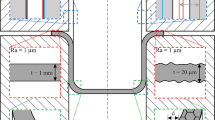Abstract
The proposed mathematical model permits shaping of worm mills for the machining of parts with helical surfaces. The model includes a module generating matrices for the spatial transformation of coordinate systems. An algorithm is presented for formulating a model of the worm-mill surface. Shaping is completed in one stage, without determining the profile of the conjugate helical rack.



Similar content being viewed by others
REFERENCES
Lashnev, S.I. and Yulikov, S.I., Raschet i konstruirovanie rezhushchego instrumenta s primeneniem EVM (Computer Calculations and Design of Cutting Tool), Moscow: Mashinostroenie, 1975.
Petukhov, Yu.E., Designing of instrumental and initial surfaces based on machine modeling methods, Cand. Sci. (Eng.) Dissertation, Moscow: Moscow State Technol. Univ., Stankin, 1984.
Kolesov, N.V. and Petukhov, Yu.E., The mathematical model of a hob with protuberances, Russ. Eng. Res., 1995, vol. 15, no. 4, pp. 71–75.
Author information
Authors and Affiliations
Corresponding author
Additional information
Translated by B. Gilbert
About this article
Cite this article
Petukhov, Y.E., Domnin, P.V. Determining Worm-Mill Profiles. Russ. Engin. Res. 40, 283–286 (2020). https://doi.org/10.3103/S1068798X20040164
Received:
Revised:
Accepted:
Published:
Issue Date:
DOI: https://doi.org/10.3103/S1068798X20040164




